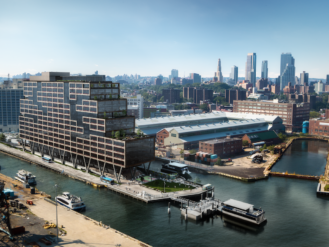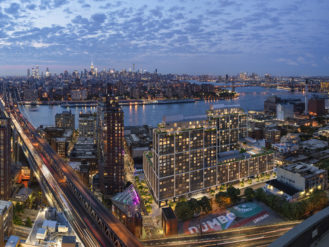Why Everyone Wants a Piece of Gowanus
Will success ruin it all over again? Or can the polluted real-estate playground survive and thrive? 6 insights from a panel of experts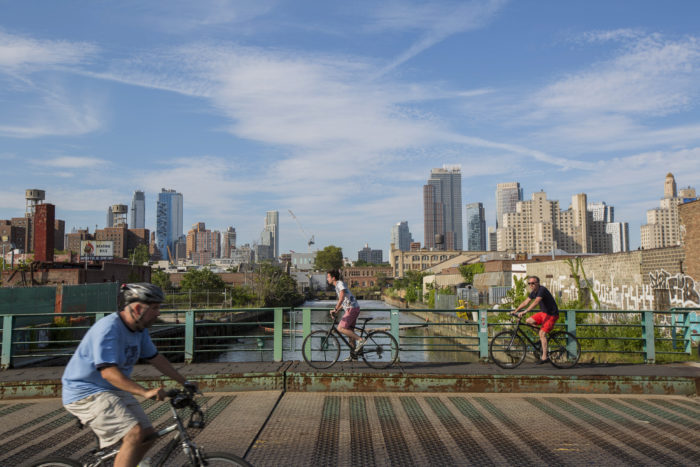
Cyclists cross the Union Street bridge, which spans the Gowanus Canal and connects Carroll Gardens with Park Slope (Hiroko Masuike/The New York Times/Redux)
The renaissance of Gowanus. Whoever thought those words would be used together? As it turns out, many who did probably got rich in real estate. The neighborhood formerly best known as a toxic-waste site is now home to thousands of artists (Arts Gowanus), luxury apartments (365 Bond), cool restaurants (Freek’s Mill), hot clubs (The Bell House), a rock-climbing mecca (Brooklyn Boulders), a prominent venture-capital firm (Brooklyn Bridge Ventures), and even an esoteric tech conference (the Ethereal Summit). Not to mention that certifier of upscale arrival: Whole Foods.
The toxic waste in the Gowanus Canal endures, awaiting the outcome of its Superfund cleanup, but now the neighborhood faces new challenges. The arrival of hundreds of millions of dollars in real-estate investment threatens to change what many people appreciated about Gowanus: its scruffy but sturdy industrial buildings, its diverse population, a thriving arts community, and a general DIY spirit of adventure. In a panel discussion this week at the Brooklyn Historical Society, titled “Gowanus’ Triple Bypass: Change Through Art, Design, and the Environment,” five aficionados of the neighborhood wrestled with the idea of balancing opportunity and preservation. “I think change is inevitable, but I don’t think any particular part of change is inevitable,” said Abby Subak, an artist and executive director of Arts Gowanus. “I hope it’s not too late to be really intentional about what kind of community we want to have.”
Joseph Alexiou, author of the fascinating Gowanus: Brooklyn’s Curious Canal and the moderator of the panel, said the Gowanus situation reflects a larger struggle: “Every story in New York City is a real-estate story.” In a thriving metropolis, the impulse to get a piece of property and assert one’s control over it runs through all civic endeavors, he said. As Exhibit A of creeping gentrification, Alexiou showed a photo of trash floating in the canal, which on closer inspection was a pile of discarded issues of the Wall Street Journal. Over the next few years, the urban struggle that Alexiou describes will determine whether Gowanus winds up looking more like every other neighborhood or retains part of its gritty flavor. Among the insights of the experts:
1. What’s repellent about Gowanus has been part of its charm
The putrid canal that bisects the neighborhood, polluted by 19th century industry and modern-day sewage overflow, helped make Gowanus attractive to artists for two overlapping reasons. The first was practical: being undesirable to other would-be gentrifiers kept the neighborhood affordable, for a time. The second was a kind of freakish aesthetic. The canal “smelled different every day, the water looked different every day. Things died in it,” said Subak. “The repulsion of Gowanus is part of its appeal for some people.” Scientists, for their part, have been drawn to Gowanus as an urban laboratory, a man-made canal interacting with the flora and fauna around it. “The landscape sparks the imagination,” said Philip Silva, an environmental researcher who lectures at The New School. Silva has brought students to Gowanus to help them “upend their expectations,” he said. The canal shows “the biotic and mechanical landscape working together. It keeps us on our toes.”
2. Gowanus has strong bones, yet they’re vulnerable
The previously abandoned factories and warehouses of Gowanus offer the perfect infrastructure for artists: big spaces, strong floors, loading docks, and mostly unobstructed daylight. Yet the pressure for residential redevelopment is stronger still, since consumer demand is great and residential buildings almost always produce more profit for developers than any other use. “People don’t always realize the connection between artists and manufacturing spaces,” said Subak. “As many are turned into residences, we’re losing real maker-spaces.” The thing to preserve is not just the old buildings, said Silva, but the artistic sensibility of the neighborhood. When neighborhoods get too heavily residential, he said, they become dreary monocultures. Fortunately, some of the Gowanus industrial space has gone back to its original purpose: manufacturing, which helps provide blue-collar jobs.
3. For certain pioneers, a less-controlled space is welcome
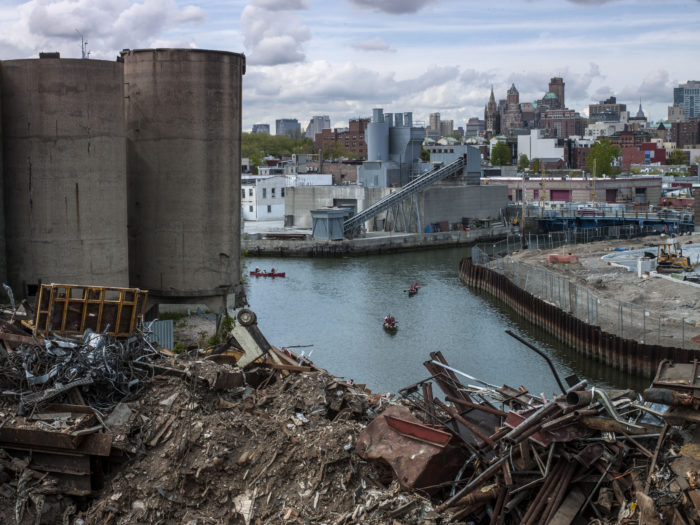
Kayakers navigate the polluted waters of the Gowanus Canal (Photo by Fritz Hoffmann/Redux)
In the chaotic visual environment of Gowanus, artists and architects have found “there’s a lot you could get away with,” said Silva. “The stakes are not that high, so it’s a big experimental playground.” Artists “need a space where anything goes,” said Subak. “The streets are not pristine, the buildings are not pristine.” The look and feel of the neighborhood changes block by block. Gowanus has “consistency in its inconsistency,” said Jared Della Valle, an architecht and CEO of Alloy, a Brooklyn real-estate development firm.
4. The water smells, but it provides what we love: waterfront
Architect David Briggs recalls his first encounters with the canal years ago while jogging from Carroll Gardens to Park Slope. “Wow, this really stinks!,” he thought to himself. “How can this be in New York? But it is.” Today, he notes, “people are trying to reconnect to the waterways,” he said. The canal provides a connection “to a larger ecosystem that the city had done a pretty good job of shutting us off from.” Silva, who grew up in Newark, where an old canal was covered over, said the Gowanus “creates diversity in the urban fabric. It’s a scar in some respects, but the waterway interrupts what would otherwise be a constant street grid.”
5. Gowanus is diverse, but that quality is slipping away
As recently as 2000, Latinos were in the majority, with 54% of the neighborhood’s population, but by last year they were down to 31%, according to U.S. Census estimates compiled by DNAinfo. Part of the cause is rezoning, which led to the demolition of many rent-stabilized buildings to make way for luxury apartments. A changing neighborhood needs to retain enough of the people “who’ve lived there forever” to have a semblance of authenticity, said Della Valle. Briggs is executive director of Gowanus by Design, a nonprofit community group that’s producing the Gowanus Atlas, an oral-history project “to try to get a sense of what their stories are about the Gowanus” and its environs, he said. The goal is “to sustain a culture before it has become homogenized by gentrification.”
6. The future will largely come down to zoning
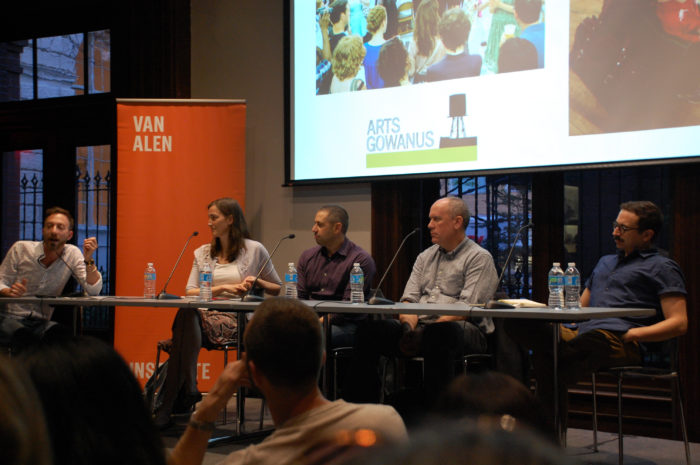
The panel at the Brooklyn Historical Society: (from left) Alexiou, Subak, Della Valle, Briggs and Silva (Photo by Steve Koepp)
The city is currently studying a rezoning of the neighborhood, which could allow more residential development. The panelists at the historical society seemed to concur that the neighborhood needs to preserve its manufacturing base as well as provide more affordable housing in order to maintain its vitality. “Development brings change,” said Della Valle, “and not all development has merit.” Briggs suggested that Gowanus should be designated “a special district with its own set of rules,” since its mix of uses is unlike many others in the city. He pointed to Long Island City as a place where stronger zoning rules for redevelopment might have prevented the rising forest of glass towers. However, “I don’t want Gowanus to become Martha’s Vineyard,” he said. “That would be awful.”
Note: the panel was presented in partnership with the Van Alen Institute






